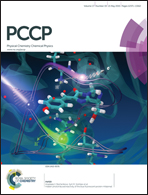In situ synthesis of Ni(OH)2 nanobelt modified electroactive poly(vinylidene fluoride) thin films: remarkable improvement in dielectric properties
Abstract
A facile and low cost synthesis of Ni(OH)2 nanobelt (NB) modified electroactive poly(vinylidene fluoride) (PVDF) thin films with excellent dielectric properties has been reported via in situ formation of Ni(OH)2 NBs in the PVDF matrix. The formation and morphology of the NBs are confirmed by UV-visible spectroscopy and field emission scanning electron microscopy respectively. A remarkable improvement in electroactive β phase nucleation (∼82%) and the dielectric constant (ε ∼ 3.1 × 106 at 20 Hz) has been observed in the nanocomposites (NCs). The interface between the NBs and the polymer matrix plays a crucial role in the enhancement of the electroactive β phase and the dielectric properties of thin films. Strong interaction via hydrogen bonds between Ni(OH)2 NBs and the PVDF matrix is the main reason for enhancement in β phase crystallization and improved dielectric properties. The NC thin films can be utilized for potential applications as high energy storage devices like supercapacitors, solid electrolyte batteries, self-charging power cells, piezoelectric nanogenerators, and thin film transistors and sensors.


 Please wait while we load your content...
Please wait while we load your content...